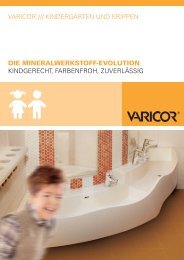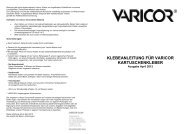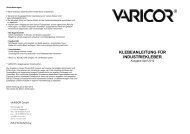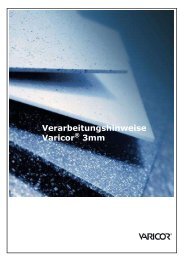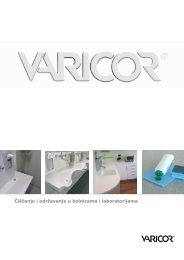Instructions for Use 3 mm - Varicor
Instructions for Use 3 mm - Varicor
Instructions for Use 3 mm - Varicor
Create successful ePaper yourself
Turn your PDF publications into a flip-book with our unique Google optimized e-Paper software.
3. GENERAL PROCESSING GUIDELINES<br />
3.1 SURFACE BONDING WITH THE SUBSTRUCTURES<br />
<strong>Use</strong> uncoated chipboards of density ≥ 650 kg m³ as carrier material.<br />
When coating the carrier material with <strong>Varicor</strong> ® 3 <strong>mm</strong>, the underside<br />
must be covered with a 0.8 <strong>mm</strong> thick HPL board as counteracting plate<br />
and steam barrier. PVAC glue is suitable as a bonding agent, D3 quality<br />
(white glue), e.g. of comp. Kleiberit Type D3, ref. 303.<br />
Be<strong>for</strong>e bonding, the individual components must be temporised to room<br />
temperature.<br />
Apply PVAC glue to the chipboard over the whole surface; then lay on<br />
the <strong>Varicor</strong> ® 3 <strong>mm</strong> panel and the counteracting plate and place the<br />
bonded panel into the veneering press.<br />
Amount of adhesive: approx. 150 – 180 g/m³<br />
Pressing pressure: approx. 3 kp/cm²<br />
Attention: always press cold<br />
Pressing time: in accordance with the data stated by the<br />
adhesive manufacturer<br />
(approx. 20 – 30 min.)<br />
Due to different expansion coefficients of the various components<br />
to be combined, changes in temperature can lead to a distortion<br />
of the composite material. Screwing the composite panel to the<br />
substructure (e.g. a base cabinet) this effect will be compensated.<br />
Prior to further processing the coated panel, please store them horizontal<br />
in a stock <strong>for</strong> one hour.<br />
3.2 BONDING VARICOR ® 3 MM WITH VARICOR® 3 MM<br />
A separate, matching colour <strong>Varicor</strong>® adhesive is available <strong>for</strong> every<br />
decorative design which enables you to realise jointless and almost<br />
invisible adhesive bonds. Some properties of the two existing types of<br />
adhesive, standard and rapid adhesive, are explained below:<br />
Based on the printed filling date, both types of adhesive will expire as<br />
follows:<br />
At room temperature at approx. 20 °C 3 months<br />
In the refrigerator at approx. 6 °C 6 months<br />
In the freezer at approx. – 20 °C 12 months except cartridge<br />
glue<br />
Standard adhesive:<br />
The following must be ensured to obtain optimum bonding:<br />
Minimum temperature of adhesive, material and room must not be<br />
under 18 °C. Lower temperatures lead to faulty bonds. Bonding agent<br />
dries, but does not harden.<br />
Please observe the hardening times of six hours at 20 °C and/or four<br />
hours at 25 °C be<strong>for</strong>e further processing.<br />
Application of the bonding agent on one side is sufficient.<br />
Rapid adhesive:<br />
This adhesive was mainly developed <strong>for</strong> assembly purposes at building<br />
sites. Processing temperatures at least 13°C.<br />
Please observe the following hardening times:<br />
60 minutes at 20° C<br />
120 minutes at 13° C<br />
For large adhered surfaces, always apply the adhesive to both sides of<br />
the surface to be bonded. Always make sure that the adhesive joints are<br />
thin because the rapid adhesive tends to <strong>for</strong>m bubbles. The adhesive<br />
joints may gleam slightly because the rapid adhesive contains a different<br />
bonding agent than the panel.<br />
Please observe the instructions <strong>for</strong> bonding enclosed with the<br />
bonding systems.<br />
Page 7 of 16



